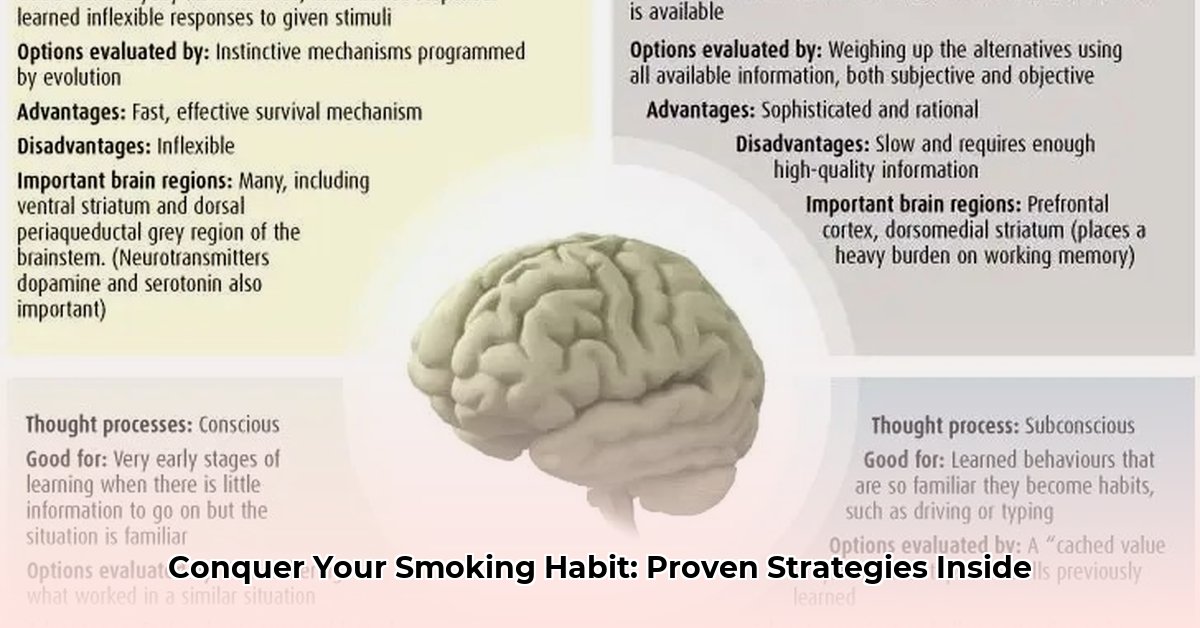Ready to quit smoking? This guide provides actionable strategies to help you take control, explore proven techniques, and build a smoke-free life by understanding your habits and developing healthier coping mechanisms. Embrace the journey and make lasting changes, one step at a time. For those interested in exploring natural alternatives, learn more about natural tobacco options.
Understanding and Overcoming Conscious Smoking Habits
Quitting smoking is a challenging process, demanding a deep understanding of ingrained habits and the application of personalized strategies. This comprehensive guide provides you with the tools to make conscious choices towards a healthier, smoke-free life. Remember, lasting change is a journey, not a fleeting event.
Breaking the Cycle: Understanding Your Smoking Habits
Smoking habits are driven by a “habit loop” consisting of triggers, routines, and rewards. Identifying and understanding this loop is crucial for disrupting the cycle of addiction. By analyzing your personal triggers and the rewards you seek, you can begin to replace the smoking routine with healthier and more fulfilling alternatives.
Actionable Steps to Uncover Your Smoking Habits:
- Trigger Tracking: Maintain a detailed journal for at least one week, meticulously noting the circumstances and emotions preceding each cigarette. Identify recurring patterns, such as stress at work, boredom at home, or social situations.
- Routine Analysis: Deconstruct the act of smoking. Describe every detail, including the location, the type of lighter and cigarette, the time of day, and your physical and mental state. This analysis reveals the specific routines and rituals associated with your smoking habit.
- Reward Recognition: Pinpoint the specific payoffs you receive from smoking. Is it stress relief, social connection, a moment of peace, or something else? Identifying the reward is essential for finding healthier ways to achieve the same satisfaction.
Mindfulness: A Powerful Tool Against Automatic Smoking
Mindfulness cultivates a heightened awareness of why you smoke, prompting a conscious examination of the sensations and emotions associated with the act. This awareness provides an opportunity to pause and question the urge each time you reach for a cigarette, disrupting the automatic response.
Practical Mindful Smoking Exercises:
- Sensory Awareness: Engage all your senses while smoking. Pay close attention to the taste, smell, texture, and even the visual appearance of the smoke. Question whether these sensations are truly enjoyable or if they are merely a conditioned response.
- Mindful Breathing: When a craving arises, take a few slow, deep breaths before reaching for a cigarette. Focus on the sensation of the air entering and leaving your body, allowing the craving to pass without acting on it.
- Body Scan: Conduct a mental scan of your body, paying attention to any physical sensations such as tension, discomfort, or restlessness. Identify ways to address these sensations without resorting to cigarettes, such as stretching, taking a walk, or practicing relaxation techniques.
Building Your Support System and Setting Achievable Goals
Set realistic goals, track your progress diligently, and celebrate every milestone along the way, no matter how small. Support from friends, family, or support groups can be invaluable. Consider using apps to monitor your progress and access resources.
Building a Robust Support Network:
- Share Your Goals: Openly communicate your desire to quit smoking with your friends, family, and colleagues. Request their understanding and support throughout your quit journey.
- Find a Quit Buddy: Seek out a friend, family member, or acquaintance who is also trying to quit smoking. Offer each other mutual support, encouragement, and accountability.
- Seek Professional Guidance: Consider consulting a therapist, counselor, or smoking cessation specialist for professional guidance and support. They can provide personalized strategies and help you navigate the challenges of quitting.
Navigating Potential Challenges:
| Challenge | Potential Solutions |
|---|---|
| Intense Cravings | Practice deep breathing exercises, engage in mindful walking, chew on healthy snacks like carrots or celery, distract yourself with a hobby or activity. |
| Stress and Anxiety | Incorporate regular exercise into your routine, practice meditation or mindfulness techniques, engage in relaxation exercises like progressive muscle relaxation, talk to a trusted friend or therapist. |
| Social Situations | Prepare in advance for social situations where smoking is prevalent, plan alternative activities that don’t involve smoking, politely decline offers for cigarettes. |
| Potential Weight Gain | Adopt a healthy eating plan, engage in regular physical activity, consult a registered dietitian for personalized guidance and support. |
Remember that quitting smoking is a highly personal journey, and there is no one-size-fits-all solution. Be patient with yourself, practice self-compassion, and celebrate every step forward, no matter how small.
Leveraging Mindfulness for Smoking Cessation and Habit Transformation
Key Insights:
- Mindfulness enhances awareness of cravings, triggers, and underlying emotions.
- Stress reduction is paramount for successful quitting, and mindfulness techniques offer effective tools for stress management.
- While research on mindfulness for smoking cessation is promising, definitive proof of its sole efficacy remains limited.
- Combining mindfulness with other evidence-based methods significantly enhances success rates.
- Consistency in practice and self-compassion are crucial for long-term success.
Mindfulness empowers you to regain control over your smoking habit by observing cravings without judgment, challenging negative self-talk, and creating space between the urge and the action.
Practical Mindfulness Techniques for Smoking Cessation:
- Mindful Breathing Exercises: When a craving arises, shift your focus to your breath. Inhale deeply, filling your lungs completely, and exhale slowly, releasing tension. Repeat this process several times, allowing the craving to subside without acting on it.
- Body Scan Meditation: Practice regular body scan meditations to cultivate awareness of physical sensations and emotions. This practice helps you to differentiate between physical cravings and emotional triggers, allowing you to respond with greater awareness and intention.
- Mindful Movement Practices: Engage in gentle movement practices like yoga or tai chi to release physical tension and shift your focus away from cravings. These practices promote relaxation and improve overall well-being.
- Acceptance and Commitment Therapy (ACT) Principles: Embrace difficult emotions and cravings without judgment, recognizing that they are temporary experiences. Focus on aligning your actions with your values and goals, even in the face of discomfort.
- Mindfulness Apps and Resources: Utilize guided meditation apps and online resources to support your mindfulness practice. These tools provide structure, guidance, and motivation to help you stay on track.
Integrating Mindfulness into Your Comprehensive Quitting Plan
Mindfulness is most effective when integrated into a broader smoking cessation strategy that addresses both the physical and psychological aspects of addiction.
- Combine mindfulness techniques with other proven methods such as medication, nicotine replacement therapy (NRT), or counseling.
- Seek support from support groups, therapists, or smoking cessation specialists.
- Set realistic and achievable goals, celebrating small wins and acknowledging setbacks as learning opportunities.
- Practice patience and self-compassion throughout your quit journey, recognizing that slips are a normal part of the process.
Overcoming Challenges in Mindfulness Practice
Be aware that challenges may arise during mindfulness practice, such as restlessness, difficulty focusing, or overwhelming emotions. If these challenges occur, remember to be patient with yourself, adjust your practice as needed, and seek guidance from a qualified instructor if necessary.
Mindfulness Techniques for Workplace Smoking Cessation
Key Considerations:
- Mindfulness-based interventions (MBIs) have demonstrated improvements in mental well-being and stress reduction among smokers, but their impact on long-term quit rates remains unclear.
- Current research does not definitively establish MBIs as superior to other evidence-based smoking cessation methods.
- MBIs are most effective when used as a complementary approach to other proven strategies, such as counseling, medication, and NRT.
- Integrating mindfulness practices into the workplace can enhance coping skills and stress management, reducing the likelihood of relapse.
- Combining MBIs with comprehensive smoking cessation programs yields the most sustainable results.
Mindfulness, the practice of paying attention to the present moment without judgment, is an invaluable tool for managing cravings and stress, two significant triggers for smoking, particularly in the workplace. MBIs have been shown to reduce stress, anxiety, and depressive symptoms, thereby improving overall well-being and increasing the likelihood of successful cessation.
Practical Mindfulness Techniques for Workplace Smoking Cessation:
- Mindful Breathing Breaks: Take short breaks throughout the workday to focus on your breath. Close your eyes, inhale deeply, and exhale slowly, allowing yourself to relax and recenter.
- Body Scan Meditations: Practice brief body scan meditations to bring awareness to different parts of your body, noticing any tension or discomfort. This practice helps you to identify and address stress before it triggers a craving.
- Mindful Walking During Breaks: Utilize your breaks to take mindful walks, paying attention to your surroundings and engaging your senses. Notice the sights, sounds, smells, and sensations of the environment, shifting your focus away from cravings.
- Sensory Awareness Exercises: Engage your senses fully by savoring the taste of your coffee or tea, appreciating the scent of flowers, or listening to calming music. These exercises help to redirect your attention away from cravings and promote relaxation.
- Acceptance and Commitment Therapy (ACT) Strategies: Accept difficult emotions and cravings without judgment, focusing on aligning your actions with your values and goals. This approach helps you to make conscious choices that support your long-term cessation goals.
Integrating Mindfulness
- Lunch Box That Fits Bento Box Neatly for Daily Use - December 5, 2025
- Japanese Lunch Bag Does Double Duty as Bento Carrier and Tote - December 4, 2025
- Your Perfect Bento Box Bag For Fresh And Tidy Meals - December 2, 2025










